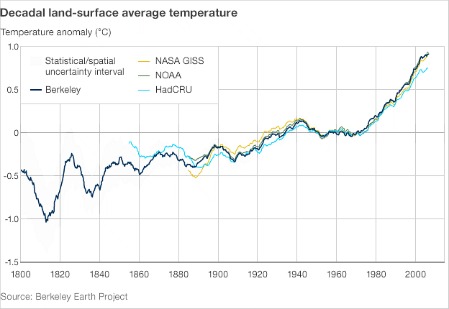Oct 24 2011
Adding to the Consensus on Global Warming
On October 20th Nature News reported on a new analysis of land temperatures by an independent group. They found the same results as previous analyses – since 1950 the earth has warmed by about 0.9 C. The results have yet to be peer-reviewed, but already reports of their analysis are making some waves.
The analysis was designed to be what can be called a consensus study – an independent group is taking a thorough analysis of the data, accounting for prior criticisms, to arrive at a result that everyone can agree on. Prior to announcing the results, in fact, some global warming skeptics stated publicly that they welcome the independent analysis and would stand by the results. PZ Myers reports on Anthony Watts response – initially saying he would accept the study results, but now considering the study to be fatally flawed.
The point of a consensus study is to bring all sides of a scientific controversy together, account for all criticisms of existing data, and then try to specifically address those criticisms so that everyone can agree on the results. This actually does happen at times, although it does seem that there remain holdouts for the view that “loses” when the new data comes out. The consensus data, however, does tend to marginalize the holdouts.
This is the way science is supposed to work – people can argue vehemently about how to interpret the data, with renewed vigor as each new piece of data comes out. But in the end everyone should be basing their opinions on the evidence, or should at least be able to agree that the evidence will ultimately determine the outcome of controversy. Part of the goal of a consensus study is to get all sides to agree on the protocol before hand, that way they cannot legitimately complain once the data comes in. Everyone, in short, has to go all-in and bet their position on the data.
James Randi has learned the value of this procedure – he always gets applicants to the JREF challenge to agree to the protocol prior to obtaining the results. Of course, once the results show they are not psychic, only then do they find flaws in the protocol. We saw the same thing with a large CDC trial on vaccines and adverse neurological outcomes. Sallie Bernard, a believer in the mercury-autism hypothesis, was consulted on the design of the study and agreed to the protocol – until the results came out. When the results were negative (no correlation between vaccines and adverse neurological outcomes) she backpedaled and distanced herself from the study.
Let’s get back to the new climate change data. Prior analysis by NASA, the NOAA, and the UK Climate Research Unit, using different but overlapping data sets, all found the same thing – the famous hockey stick of recent temperature increase. However there has been a lot of criticism of the data – that there are artifacts in the ways in which they adjusted temperatures for time of day and other variables, and accounted for the urban heat island effect – that cities are warmer and are getting bigger. Statistical analysis of the data is complex, creating legitimate concern about the introduction of artifacts into the analysis, but also creating the opportunity to deny the results if you don’t like them.
 So a completely independent analysis was in order – part of the replication that is demanding by good science. Richard Muller, a physicist at the University of California, Berkeley, undertook the Berkeley Earth Surface Temperature study. They looked at a more complete data set, essentially combining all the data of the three previous analyses, and also devised their own statistical analysis. What they found pretty much exactly matches the prior three studies. They confirmed the hockey stick of temperature rise. As you can see from the chart – the lines overlap almost completely.
So a completely independent analysis was in order – part of the replication that is demanding by good science. Richard Muller, a physicist at the University of California, Berkeley, undertook the Berkeley Earth Surface Temperature study. They looked at a more complete data set, essentially combining all the data of the three previous analyses, and also devised their own statistical analysis. What they found pretty much exactly matches the prior three studies. They confirmed the hockey stick of temperature rise. As you can see from the chart – the lines overlap almost completely.
This analysis not only confirms that global warming is happening, it confirms the legitimacy of the three prior analyses. Despite all the criticism, the methods used were apparently accurate.
I need to point out that the analysis still has to be peer-reviewed. In addition the researchers are making their methods and data public and more easily accessible than the previous data sets, so we should expect a great of picking over these results. That’s all good. Science needs to be transparent. We will see what the result of peer-review is. If the analysis survives peer-review, then we can also expect that this will strengthen the consensus among scientists that global warming is a real phenomenon.
But we know that this is an ideologically hot topic, and there are those who deny that global warming is happening (while there are others that acknowledge global warming and just deny the degree to which it is man-made, or that current proposals can do anything about it). I don’t expect this data to convert many dissidents – we’ll see. However (again – if it holds up) it will marginalize their view. It will strengthen the consensus. To the degree that science is used to inform political action, a strong consensus on the science is very helpful.
This replication will likely have that effect. How it is translated into political action remains to be seen.






